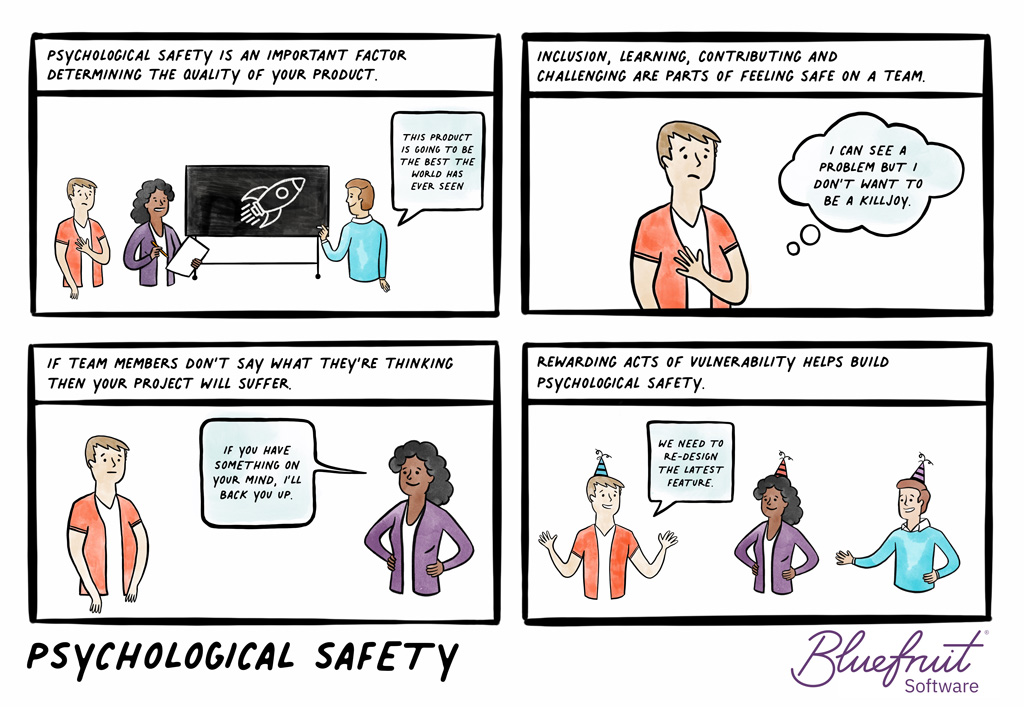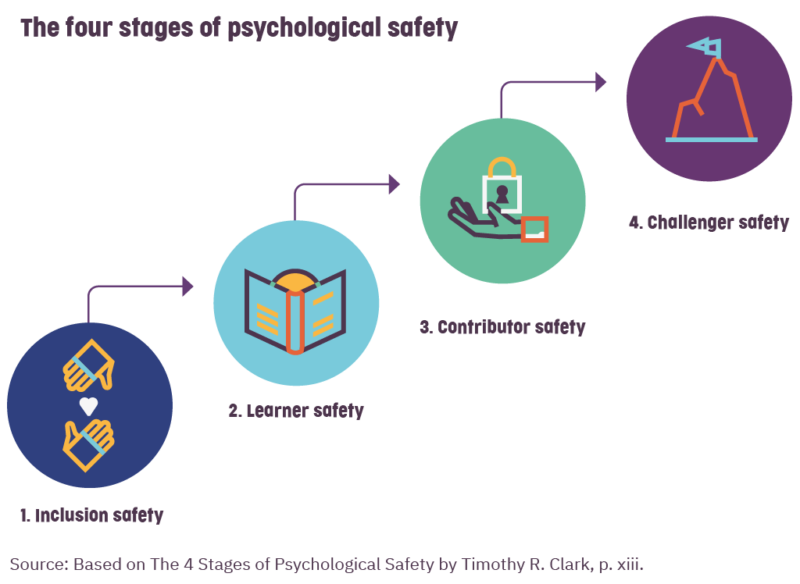Psychological safety in the workplace
Psychological safety in the workplace revolves around employee engagement and disengagement.
Often, business leaders may believe that psychological safety in their business is high when it’s not. They also might mistake it for workplace culture.
But what is psychological safety, why should you want it for your teams, and how can you improve it? Read on to find out.
Psychological safety is more than workplace culture
Workplace culture can exist without psychological safety, but a culture without psychological safety is an ineffective and oppressive culture. Culture is just the environment you create, but psychological safety (or its absence) impacts how people function within it.
William Kahn first popularised the term in a 1990 article on the subject. His theories were based on ideas that had begun with Warren G. Bennis and Edgar Schein in the 1960s.
Amy Edmondson of Harvard Business School builds on Kahn and describes psychological safety like this:
“Psychological safety means an absence of interpersonal fear. When psychological safety is present, people are able to speak up with work-relevant content.”
Source: McKinsey & Company
Timothy R. Clark takes the concept further still and describes it like this:
“Psychological Safety is a condition in which you feel (1) included, (2) safe to learn, (3) safe to contribute, and (4) safe to challenge the status quo—all without fear of being embarrassed, marginalized, or punished in some way.”
Source: The 4 Stages of Psychological Safety by Timothy R. Clark, p. 2.
It’s Clark’s ideas that we’ll explore further in this blog post.
Why should you care about psychological safety?
Let’s examine why psychological safety is important by looking at two scenarios that could affect you.
Scenario: A phishing attempt
Imagine: one day, dozens of your colleagues receive text messages on their work or personal mobile phones asking them to click a link to a payroll platform. The link looks like the correct domain address for your business’s payroll platform.
When clicked through, the site looks like a genuine version of that payroll platform’s website. There is a login page asking for a username and password.
The outcome with psychological safety
Thankfully, despite several colleagues falling for the fake site and submitting login details, nothing terrible happens. Your business’s cybersecurity practices stop the attackers who sent the SMS using the login details.
Equally as good, your workplace culture says it’s okay for people to make mistakes. And those who shared their details aren’t punished for their error. Meanwhile, people felt empowered and engaged enough to report the incident early, helping the cybersecurity team address the matter quickly and effectively.
Scenario: Do you need that additional product feature?
Let’s imagine your software team is working on a new device. It has many features already planned out in its backlog. Most have clear links to business value and look desirable to end users.
The team and stakeholders have prioritised the backlog by:
- The cost of development,
- Financial value,
- How much learning and new knowledge user stories offer,
- And the risk involved in developing them.
They regularly update the backlog as new insights about the project surfaced.
And then, one of your stakeholders starts pushing hard for an additional feature to be added. The new feature would mean that the product can jump on a new tech trend that’s unproven regarding marketability.
The outcome with psychological safety
For the stakeholder to feel comfortable pushing for this new feature is evidence that they have psychological safety. But what about the software team?
Because your business has invested in developing psychological safety, the software team can push back and go, “Hold on a sec.”
The team doesn’t outright say “no” but asks for supporting evidence . First, the feature is evaluated as the other backlog items were. The feature scores indicate it is high risk and has low value. And because it’s based on a new trend that not may companies have tried in their products yet, the team also asks for some UX research to happen.
The UX research shows that many users won’t like or use this new feature. Finding this out early saves development and future maintenance costs, reducing the risk of technical debt and keeps the project on schedule.
Psychological safety has benefits across an organisation
From these two examples, you can see the benefits of psychological safety.
Psychological safety means:
- Your teams are actively engaged in their work, increasing discretionary effort.
- Your teams are empowered to speak up, offering ideas and warnings.
- You gain improved cohesion and communication across your organisation.
- You decrease risks to your org while fostering innovation.
So, how can you improve psychological safety in your workplace?
4 steps to boost psychological safety at your workplace
Clark sees the development of psychological safety in the workplace as four steps or stages.
To move up each step or stage, you need to have traversed the previous one. Only with all four stages complete can you have the positive outcomes described above.
Here’s how to move up those steps, according to Clark.
Step one: build inclusion safety
Here, you’ll:
- Respect the individual humanity of colleagues throughout your company, regardless of seniority and enable colleagues to do the same for each other.
- Provide “permission” for individuals to interact with you and others as “human beings” rather than compel them to hide their true selves.
- Offer the above without needing someone to prove that they deserve to be treated as a person.
Step two: build learner safety
Here you’ll:
- Respect that everyone has an “innate need to learn and grow”.
- Support learning and enable colleagues to take part in every “learning process”.
- Offer the above so that people not only want to learn but are encouraged to engage with the business.
Step three: build contributor safety
Here you’ll:
- Respect that everyone in your workplace can “create value”.
- Give people space to work independently and use their judgement (no micromanaging).
- Offer the above alongside “guidance” so that people can work without fear that they are on their own.
Step four: build challenger safety
Here you’ll:
- Respect that colleagues in your workplace can “innovate”.
- Provide permission for colleagues to “challenge the status quo in good faith”.
- Offer “cover” so that when people speak up, they can do so without fear or risk of punishment or belittlement.
If you’d like to learn more about Timothy R. Clark’s ideas around psychological safety, try reading his book The 4 Stages of Psychological Safety.
Alternatively, you could read our short ebook to discover what psychological safety means for you workplace, and software and hardware development projects.
What is psychological safety in the workplace?
Psychological safety in the workplace means that your teams are empowered to be a part of your business in a way that treats them with dignity and respect. It means that individuals will feel they can learn and contribute in meaningful ways.
The benefits of this are vast, from innovation to reduced business risk.
If you’d like to learn more about psychological safety and how it can impact software projects, download your copy of Why is psychological safety critical to managing software risk? today.
Why is psychological safety critical to managing software risk? will help you
- Gain a deeper understanding of the four stages of psychological safety.
- See how psychological safety impacts risk in teams and whole organisations.
Download your ebook and answer:
Did you know that we have a monthly newsletter?
If you’d like insights into software development, Lean-Agile practices, advances in technology and more to your inbox once a month—sign up today!
Find out more